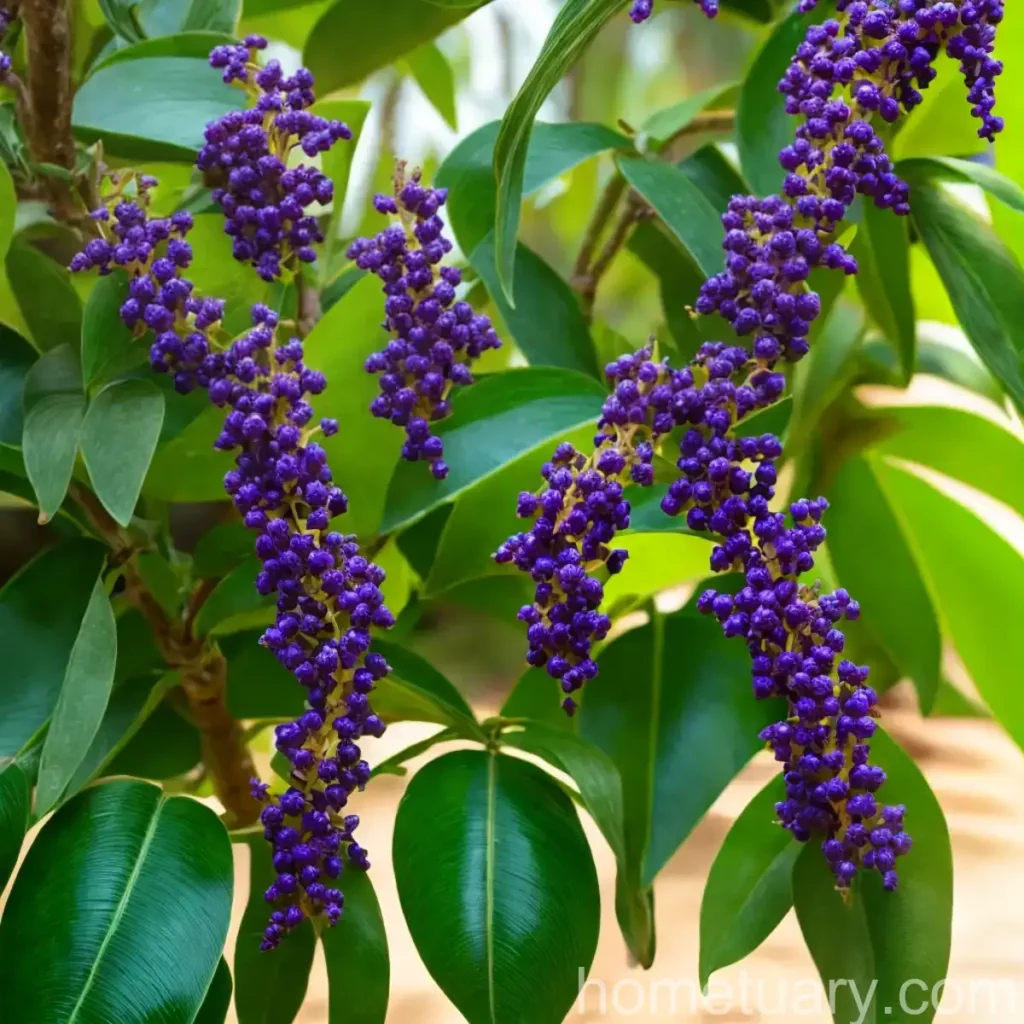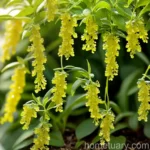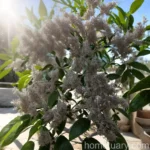Pigeon Berry (Duranta erecta ‘Cuban Gold’): A Guide for Cultivation and Care
Pigeon berry, scientifically known as Duranta erecta ‘Cuban Gold’, is a versatile and vibrant shrub that is valued for its ornamental foliage and delicate flowers. This plant has gained popularity in landscaping due to its low maintenance requirements and aesthetic appeal. In this comprehensive guide, we will delve into the culture, uses, care requirements, propagation, common diseases, and interesting facts about the pigeon berry plant.
What is a Pigeon Berry (Duranta erecta ‘Cuban Gold’)?
The pigeon berry, or Duranta erecta ‘Cuban Gold’, is a tropical evergreen shrub known for its striking, bright golden foliage. This plant belongs to the Verbenaceae family and is native to the Caribbean, Mexico, South America, and the Florida Keys. It is characterized by its dense, bushy growth habit and clusters of small, tubular, light blue to lavender flowers that often give way to ornamental golden berries, adding to the visual interest of the plant.
Key Takeaways – Pigeon Berry (Duranta erecta ‘Cuban Gold’)
Before diving into the specifics of cultivating and caring for the pigeon berry, let’s outline the key takeaways of this distinctive plant:
- Scientific Name: Duranta erecta ‘Cuban Gold’
- Common Names: Pigeon berry, Cuban Gold plant
- Plant Type: Tropical evergreen shrub
- Foliage: Vibrant, golden-yellow leaves
- Flowers: Small, tubular, light blue to lavender
- Berries: Ornamental golden berries
- Uses: Ornamental landscaping, hedges, and containers
- Attributes: Drought-tolerant, low maintenance, and attracts wildlife
- Hardiness Zones: 9 to 11
Now that we have a broad understanding of the pigeon berry plant, let’s explore the various aspects of its culture and care, along with its uses and benefits in landscaping.
Culture of Pigeon Berry (Duranta erecta ‘Cuban Gold’)
The successful cultivation of the pigeon berry plant relies on understanding its specific cultural requirements. By providing the right conditions, you can ensure the optimal growth and vigor of this ornamental shrub.
Water
Pigeon berry plants have moderate water needs and are notably drought-tolerant once established. However, regular watering is essential, especially during the establishment phase and in prolonged dry spells. It is vital to ensure consistent moisture levels, particularly in well-draining soils, to promote healthy growth and prevent water stress. Overwatering, which can lead to root rot, should be avoided, especially in poorly draining soils.
Sunlight
Cuban Gold plants thrive in full sunlight, basking in the warmth and brightness of direct sunlight for most of the day. To maintain the vibrant golden color of the foliage, it is crucial to provide ample sunlight. Insufficient light can lead to leggy growth and a loss of the characteristic golden hue. In regions with scorching heat, providing some afternoon shade can help protect the plant from stress caused by intense sunlight.
Soil
The pigeon berry plant prefers well-draining, fertile soils with a slightly acidic to neutral pH range. Loamy soils with good aeration are ideal for promoting healthy root development and overall growth. Amending the soil with organic matter, such as compost, can help improve its structure and fertility. It is essential to avoid waterlogged or compacted soils, as they can lead to root suffocation and poor nutrient uptake.
Fertilizer
When it comes to fertilization, pigeon berry shrubs benefit from a balanced, slow-release fertilizer applied in early spring. Selecting a fertilizer with a formulation such as 10-10-10 or 14-14-14 can provide the necessary macro and micronutrients for robust growth and prolific flowering. Following the application instructions on the fertilizer label and avoiding excessive fertilization are key to preventing nutrient imbalances and potential damage to the plant.
Pruning
Pruning plays a crucial role in maintaining the desired shape and size of the pigeon berry plant, promoting air circulation, and removing dead or diseased growth. Regular pruning of spent flowers and excessive growth can encourage continuous blooming and a compact, bushy form. It is best to prune the plant in late winter or early spring before the onset of new growth. Using clean, sharp pruning shears and making precise cuts can contribute to the plant’s overall health and appearance.
Uses of Pigeon Berry (Duranta erecta ‘Cuban Gold’)
The pigeon berry, with its captivating foliage and charming berries, offers a range of uses in landscaping and garden designs. Its versatility and hardiness make it a favored choice for various applications.
-
Ornamental Landscaping: Pigeon berry shrubs serve as eye-catching focal points in garden beds, borders, and mixed shrub borders, contributing vibrant color and visual interest to the landscape.
-
Hedge and Border Plant: When planted in a row, the pigeon berry can be trained as a hedge, creating a stunning barrier with its dense, golden foliage. It also works well as a border plant along pathways or around other garden features.
-
Container Planting: The compact growth habit of pigeon berry makes it well-suited for container planting on patios, porches, and balconies, where its bright foliage can add a cheerful touch to outdoor spaces.
-
Wildlife Attraction: The flowers of the pigeon berry plant attract pollinators such as butterflies and bees, contributing to the overall biodiversity of the garden. Additionally, the golden berries produced by the plant can be a food source for birds, adding a wildlife-friendly element to the landscape.
Propagation of Pigeon Berry (Duranta erecta ‘Cuban Gold’)
Propagation of pigeon berry shrubs can be achieved through various methods, including seeds, cuttings, and division. By selecting the most suitable propagation technique, gardeners can expand their collection of these striking plants and share them with fellow gardening enthusiasts.
Seed Germination
Pigeon berry seeds can be collected from mature berries and sown in seed-starting trays or pots filled with well-draining potting mix. The seeds should be lightly covered with a thin layer of soil, and the growing medium should be kept consistently moist but not waterlogged. Placing the trays in a warm, bright location can promote successful germination. Once the seedlings have developed several sets of true leaves, they can be transplanted into individual pots or directly into the garden.
Stem Cuttings
Taking stem cuttings from healthy, vigorous pigeon berry plants is a reliable method of propagation. The cuttings, typically around 4 to 6 inches long, are best obtained from semi-hardwood or hardwood growth. After removing the lower leaves from the cuttings, they can be dipped in a rooting hormone to promote the development of roots. The cuttings are then planted in a well-draining, moist rooting medium and provided with the appropriate warmth and humidity for successful root formation.
Division
Mature pigeon berry shrubs can be divided to create new plants and rejuvenate existing ones. This method is best performed during the plant’s dormant period, typically in early spring. By carefully digging up the root ball and dividing it into sections, each containing viable roots and shoots, gardeners can propagate the pigeon berry while simultaneously managing its size and rejuvenating older, crowded plants.
Container Popularity
The compact growth habit and striking appearance of the pigeon berry make it a popular choice for container gardening enthusiasts. Its ability to thrive in pots, combined with its low maintenance requirements, vibrant foliage, and occasional flowering, adds an inviting touch to patios, decks, and outdoor living spaces.
In a containerized setting, the pigeon berry can be showcased individually as a specimen plant or incorporated into mixed container gardens, offering a bright pop of color against the backdrop of other foliage plants. When situating the container, it is crucial to ensure that the pigeon berry receives adequate sunlight and regular watering to support its growth and visual appeal.
Common Diseases of Pigeon Berry (Duranta erecta ‘Cuban Gold’)
As with any plant, pigeon berries may be susceptible to certain diseases, which can affect their overall health and appearance. Understanding the common diseases and their management is essential for maintaining the vigor of the plant in the landscape.
Disease Diagnosis
-
Powdery Mildew: A fungal disease that presents as a powdery, white coating on the foliage of the plant. It thrives in humid conditions and can weaken the plant over time. To mitigate powdery mildew, ensuring good air circulation, avoiding overhead irrigation, and applying fungicidal sprays can help control its spread.
-
Leaf Spot: This fungal disease causes the appearance of dark, water-soaked spots on the leaves of the plant. To manage leaf spot, removing and disposing of affected plant material, practicing good sanitation, and applying fungicidal treatments can prevent the disease from spreading and minimize its impact on the plant.
-
Root Rot: Excessive moisture, poorly draining soils, and fungal pathogens can contribute to root rot in pigeon berry plants, leading to wilting, yellowing foliage, and overall decline. Improving soil drainage, adjusting watering practices, and selecting disease-resistant cultivars can help prevent the onset of root rot and maintain the plant’s vitality.
Common Pests Affecting Pigeon Berry (Duranta erecta ‘Cuban Gold’)
In addition to diseases, pigeon berry plants may also encounter pests that can compromise their health and aesthetics. Identifying and addressing common pests promptly is essential for protecting the plant from potential damage and stress.
Pest Identification
-
Aphids: These small, soft-bodied insects often congregate on new growth and the undersides of leaves, sucking plant sap and potentially causing distorted foliage. Managing aphids involves using natural predators, such as ladybugs, or applying insecticidal soaps to reduce their population and protect the plant.
-
Scale Insects: Scale insects, appearing as small, oval-shaped bumps on stems and foliage, can weaken the plant by feeding on its sap and reducing its overall vigor. Introducing natural enemies, such as parasitic wasps, and using horticultural oils can help control scale infestations and prevent damage to the plant.
-
Spider Mites: These tiny pests are known for webbing on the foliage, along with stippling and discoloration caused by their feeding activities. Increasing humidity, employing predatory mites, and using miticides can effectively manage spider mite infestations and safeguard the health of the pigeon berry plant.
By regularly inspecting the plant for signs of pest infestations and undertaking appropriate management strategies, gardeners can protect the pigeon berry from the detrimental effects of common pests and maintain its vitality.
Botanist’s Tips for Pigeon Berry (Duranta erecta ‘Cuban Gold’)
Incorporating expert tips into the care and cultivation of pigeon berry shrubs can elevate the overall success and enjoyment of growing these striking ornamental plants. Here are some valuable guidelines to consider when stewarding the health and beauty of pigeon berry (Duranta erecta ‘Cuban Gold’):
-
Monitor Moisture Levels: Regularly check the moisture content of the soil, especially during the establishment phase and in periods of prolonged heat and dryness, to ensure the pigeon berry receives adequate hydration.
-
Mulch Application: Applying a layer of organic mulch around the base of the pigeon berry plant can help conserve soil moisture, suppress weed growth, and provide a gradual release of nutrients as the mulch decomposes.
-
Integrated Pest Management: Embrace a holistic approach to pest management by promoting natural predator populations, implementing cultural practices, and using targeted interventions to minimize the impact of pests on the pigeon berry plant.
-
Regular Observation: Periodically inspect the plant for any signs of diseases, pests, or nutrient deficiencies, enabling timely intervention and the preservation of the plant’s overall health and beauty.
-
Seasonal Care: Tailor the care and maintenance of pigeon berry shrubs to accommodate seasonal changes, such as adjusting watering frequency, applying appropriate fertilizers, and executing pruning tasks at the optimal times.
Fun Facts About Pigeon Berry (Duranta erecta ‘Cuban Gold’)
Delving into the intriguing characteristics and historical significance of the pigeon berry plant can reveal captivating and lesser-known facts that enrich our appreciation for this ornamental shrub. Here are some fun and noteworthy facts about the pigeon berry:
-
Attractive to Birds: The golden berries produced by the pigeon berry plant are not only ornamental but also attract various bird species, adding a delightful element of wildlife interaction to the garden.
-
Cuban Origin: The ‘Cuban Gold’ variety of Duranta erecta traces its origin to Cuba, where it has long been cherished for its striking foliage and versatile uses in garden designs.
-
Tropical Relatives: Pigeon berry, as a member of the Verbenaceae family, shares botanical ties with other tropical and subtropical plants known for their ornamental value and ecological contributions.
-
Symbolic Significance: In some cultures, the pigeon berry plant is associated with positive attributes and traditional beliefs, contributing to its symbolic and cultural significance.
Uncovering these fascinating aspects of the pigeon berry plant can deepen our connection to it and enhance the storytelling potential within garden designs and landscapes.
Links to External Resources
For comprehensive information, practical guidance, and inspirational ideas related to pigeon berry (Duranta erecta ‘Cuban Gold’), the following external resources offer valuable insights and perspectives:
By exploring these resources, gardeners and plant enthusiasts can expand their knowledge, exchange experiences, and gain inspiration for integrating pigeon berry into their personal gardening endeavors and landscape projects.
In conclusion, the pigeon berry (Duranta erecta ‘Cuban Gold’) stands as a captivating and resilient shrub with widespread appeal in ornamental landscaping and horticulture. Its vibrant foliage, charming flowers, and low maintenance requirements make it an attractive choice for gardeners seeking a striking and versatile plant for their outdoor spaces. With a deeper understanding of its culture, care requirements, uses, and ecological significance, the pigeon berry can continue to shine as a gem among ornamental plants, enriching gardens and landscapes with its distinctive presence.















